Table of Contents
Introduction
Smarter Devices Statistics: Smarter devices encompass many technologically advanced gadgets vital to the Internet of Things (IoT) world.
These devices are known for their connectivity, automation capabilities, data-gathering abilities, and intelligence. They include smartphones, smart home gadgets, wearable tech, connected vehicles, and industrial IoT tools.
They offer advantages such as convenience, increased efficiency, cost savings, safety improvements, and health-related benefits. However, they also come with privacy concerns, security risks, compatibility issues, and energy usage.
The market for smarter devices is rapidly expanding due to growing consumer interest and technological advancements. With future trends emphasizing 5G connectivity, edge computing, and personalized experiences driven by AI.
As these devices continue to develop, they have the potential to transform how we engage. Technology has a significant impact on various industries.
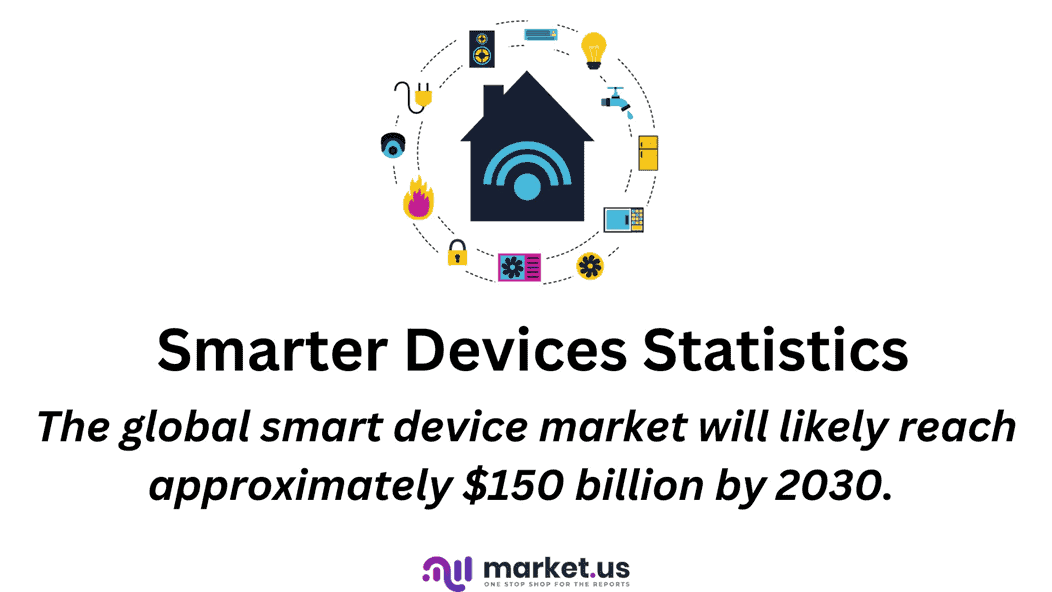
Editor’s Choice
- Enterprise IoT Market size is expected to be worth around USD 1819.2 Bn by 2032
- In 2022, the worldwide smart device market had an estimated worth of about $49.04 billion. And it will likely reach approximately $150 billion by 2030.
- It’s expected to see an average annual growth rate of around 15% during this period.
- As of 2022, an estimated 6.5 billion smartphone subscriptions were actively used. Expected to climb to nearly eight billion by 2028.
- In 2023, the global shipment total for smart home devices amounted to approximately 857 million units. A significant portion of these, around 278 million units, fall within the video entertainment category.
- Predictions point to a remarkable growth in the total count of IoT devices across all industries, reaching beyond eight billion by 2030.
- 49% of individuals who utilize connected devices have faced at least one data security or privacy issue.
- According to research by Parks Associates, 72% of consumers express varying levels of concern. Many are very concerned about the security of their data collected and transmitted by devices.
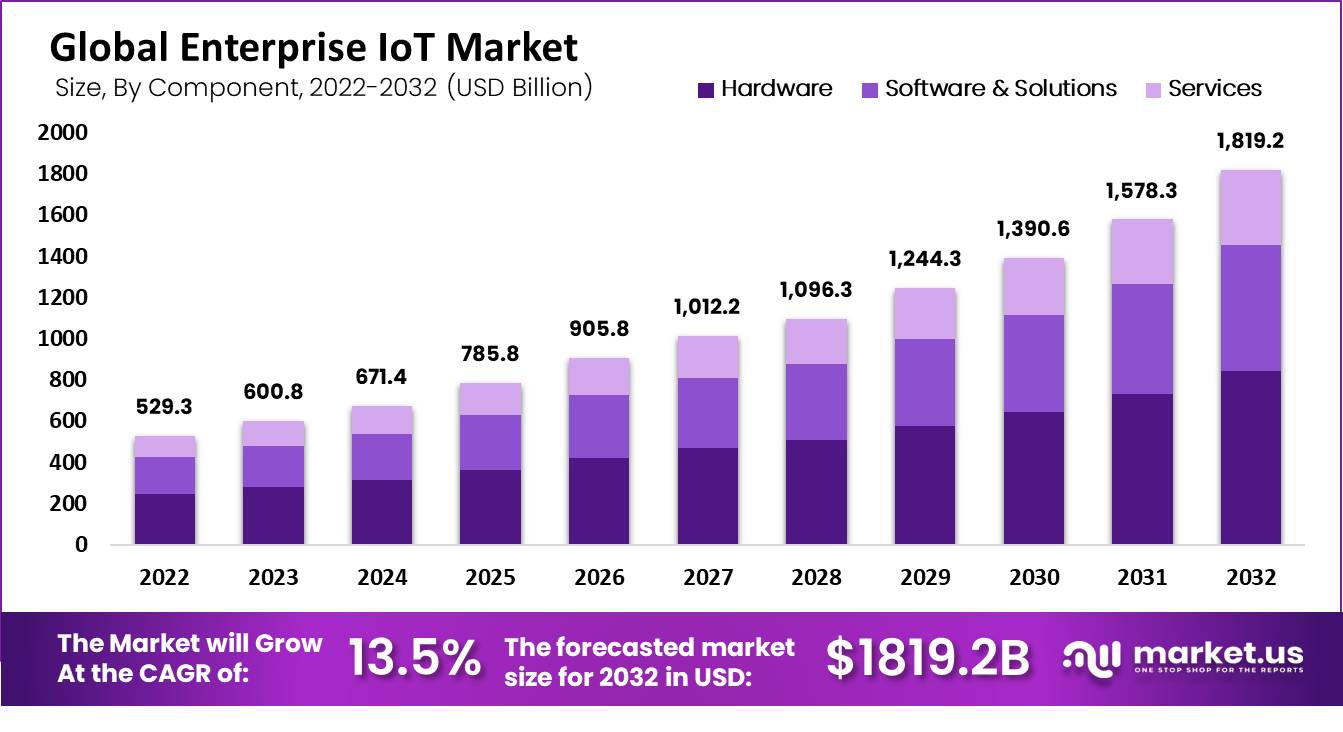
Smart Devices Market Statistics
- IoT device management is projected to reach USD 31.33 billion at a CAGR of 31.2%.
- In 2022, the worldwide smart device market had an estimated worth of about $49.04 billion. Experts predict that it will likely reach approximately $150 billion by 2030.
- It’s expected to see an average annual growth rate of around 15% during this period.
- In 2020, the most prominent category within this market was wrist-worn devices. Making up more than 48.9% of the total market share.
- From 2021 to 2028, the eyewear and headwear product segment is forecasted to grow at a compounded annual growth rate (CAGR) of 14.2%.
- In 2020, North America was at the forefront, accounting for over 34.7% of global sales.
(Source: Virtue MR)
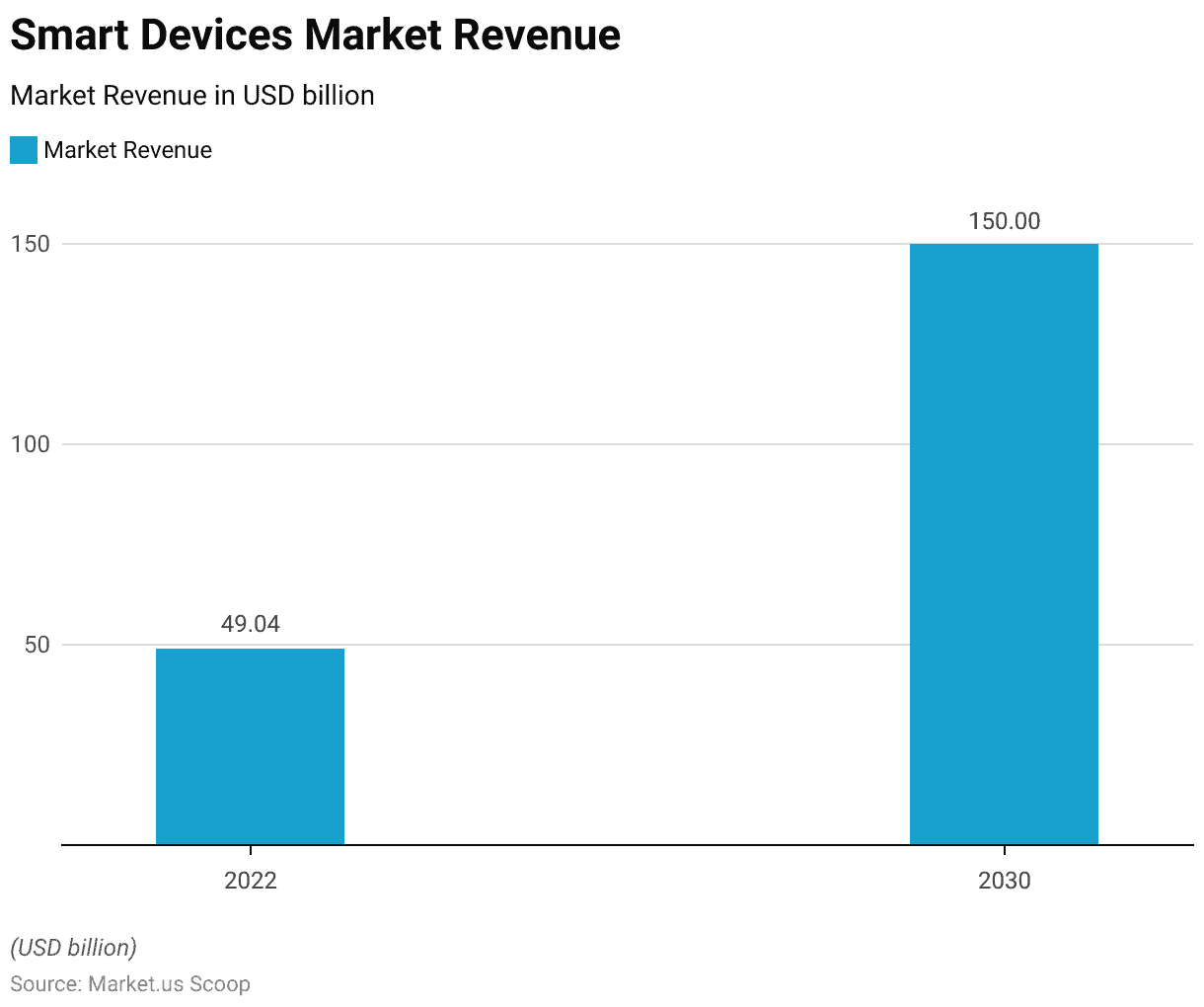
Types of Smarter Devices Statistics
Smartphones and Tablets
- Since 2008, the smartphone industry has consistently expanded in market size and the diversity of available models and manufacturers.
- In 2022, the worldwide shipments of smartphones reached approximately 1.2 billion units. Although there was a slight dip compared to the previous year.
- By the end of 2022, about 68% of the global population will own smartphones. Notably, many individuals utilize multiple smartphones, leading to the actual count of smartphone subscriptions exceeding the number of users.
- As of 2022, an estimated 6.5 billion smartphone subscriptions were actively used. Expected to climb to nearly eight billion by 2028.
- In 2022, the global smartphone usage rate reached an estimated 68%, marking an increase for the first time since 2018.
- This calculation is based on roughly 6.3 billion smartphone subscriptions worldwide in a population of approximately 7.4 billion people.
- The adoption of smartphones varies significantly across the world. For instance, in North America and Europe, the rate of smartphone usage is approximately 82% and 79%, respectively.
- In contrast, in Sub-Saharan Africa, this rate is only about 64% as of late 2021. Illustrating a considerable gap of around 20% in adoption rates between the regions with the highest and lowest smartphone usage.
- Tablet shipments reached their highest point in 2014 and have been on a gradual decline ever since.
- Projections indicate that 2023 global tablet shipments are expected to reach 143 million units. Marking a decline from the peak of 230 million units in 2014.
- Apple maintains its leadership position as the foremost tablet vendor in shipments. Samsung and Amazon closely vying for a share of the tablet market.
- Apple has consistently held a market share of more than 30% in tablet shipments in recent years.
(Source: Statista)
Take advantage of our unbeatable offer - buy now!

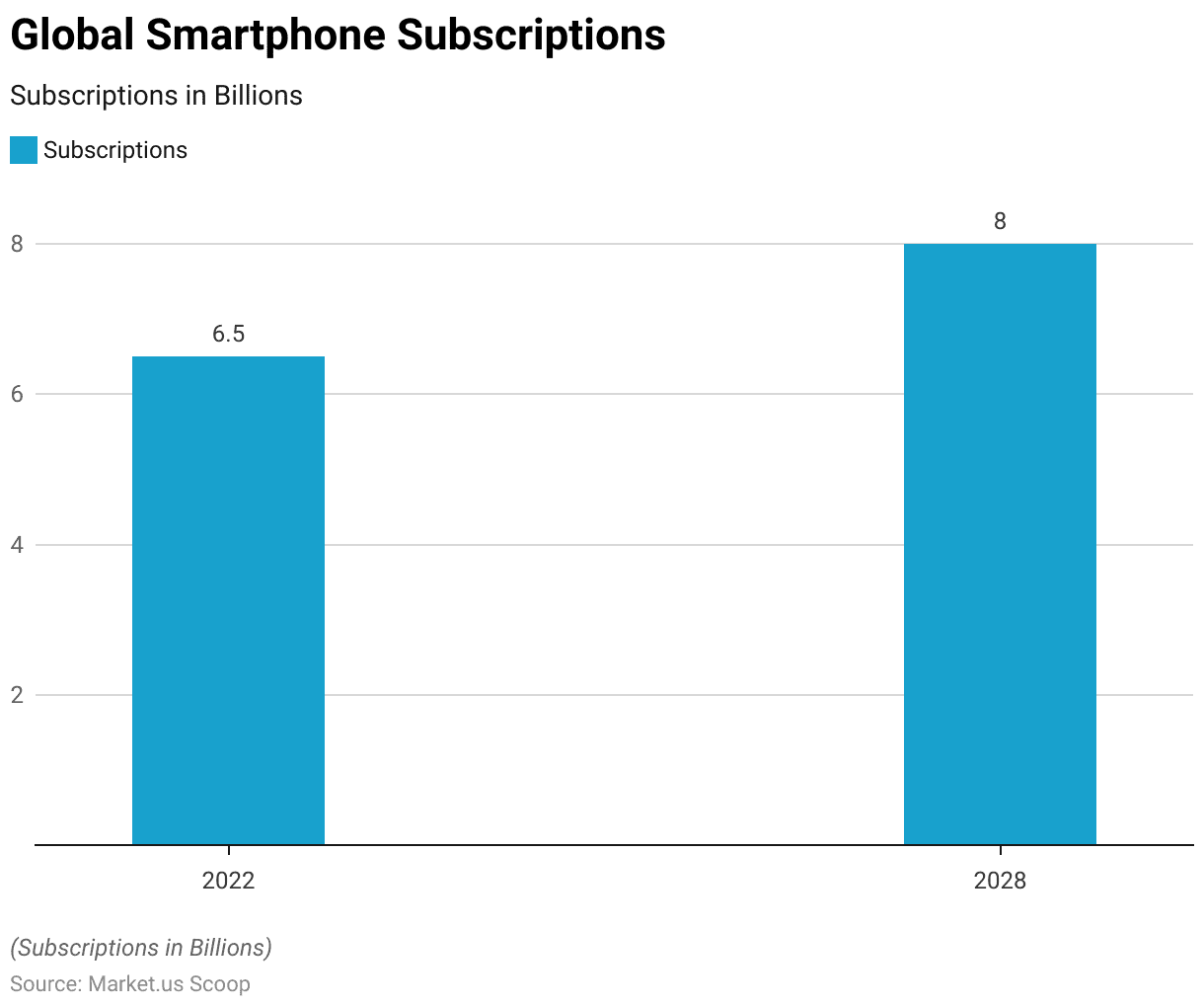
Smarter Home Devices Statistics
- In 2023, the global shipment total for smart home devices amounted to approximately 857 million units. With a significant portion of these, around 278 million units, fall within the video entertainment category.
- Among the specific device types, lighting is projected to experience the most substantial growth between 2023 and 2027. With a compound annual growth rate (CAGR) of 13.6%.
- Home monitoring and security devices include video surveillance cameras and doorbells.
- Thanks to robust offerings like Google’s Nest and Arlo Pro devices (formerly associated with Netgear). The market for network video surveillance reached an estimated revenue of about 1.1 billion U.S. dollars by the close of 2018.
- Video doorbells, a relatively new segment in the smart home market, are closely related to home security cameras and are expected to see spending rise to 1.4 billion U.S. dollars by 2023.
- The “other” category of smart home devices is yet another segment poised for significant growth in terms of shipments.
(Source: Statista)
Wearable Technology
- As the name implies, wearables are designed to be worn on the body. These gadgets typically incorporate smart sensors and connect to the internet for data transmission, logging, or analysis.
- Pulsar‘s calculator wristwatch can be credited as one of the earliest consumer wearables to achieve global popularity.
- Some noteworthy milestones in wearable technology include the introduction of the first Bluetooth headset in 2000 and the launch of the inaugural GoPro camera in 2004.
- In 2013, Google Glass debuted as the first voice-controlled, optical, head-mounted display offering hands-free internet access. Augmented reality features, and image capture capabilities.
- Currently, the most successful wearable devices in the market encompass smartwatches and health/fitness trackers.
- With the relatively recent category of “wearables” emerging as the dominant player.
- Projections indicate that over 340 million earwear units are expected to be shipped in 2023. While smartwatch shipments are anticipated to reach just under 160 million units in the same year.
- Leading vendors in the wearables sector include Apple, Xiaomi, Huawei, and Samsung, with Apple holding the largest market share.
- Apple‘s prominent position in the wearables market is primarily attributed to the success of the Apple Watch. Which has established its dominance within the broader wearables industry.
- Indeed, Apple shipped approximately 146 million wearable devices in 2022.
(Source: Statista)
Smarter IoT Devices Statistics
- The Internet of Things (IoT) Statistics have displayed and witnessed exponential growth in connected devices worldwide.
- In 2019, there were 8.6 billion IoT-connected devices, which surged to 9.76 billion in 2020.
- The trend continued with 11.28 billion devices in 2021 and a significant leap to 13.14 billion in 2022.
- Projections indicate even more remarkable expansion in the coming years. With an estimated 15.14 billion IoT devices are expected to be connected in 2023.
- As we look further into the future, the IoT ecosystem is set to grow exponentially. With forecasts predicting 29.42 billion IoT-connected devices globally by 2030.
- This data highlights the ever-increasing integration of smart devices into our daily lives. Revolutionizing industries and enhancing connectivity on a global scale.
- Numerous major industry sectors currently boast over 100 million connected IoT devices, including electricity, gas, steam, air conditioning, water supply, waste management, retail, wholesale, transportation, storage, and government.
- Predictions point to a remarkable growth in the total count of IoT devices across all industries, reaching beyond 8 billion by 2030.
- In consumer applications, the most substantial utilization of IoT devices revolves around consumer internet and media tools, primarily smartphones. Estimates indicate that the quantity of IoT devices in this category will exceed 17 billion by 2030.
- Furthermore, other notable use cases are poised to surpass one billion IoT devices by 2030, encompassing connected (autonomous) vehicles, IT infrastructure, asset tracking and monitoring, and smart grid systems.
(Source: Statista)
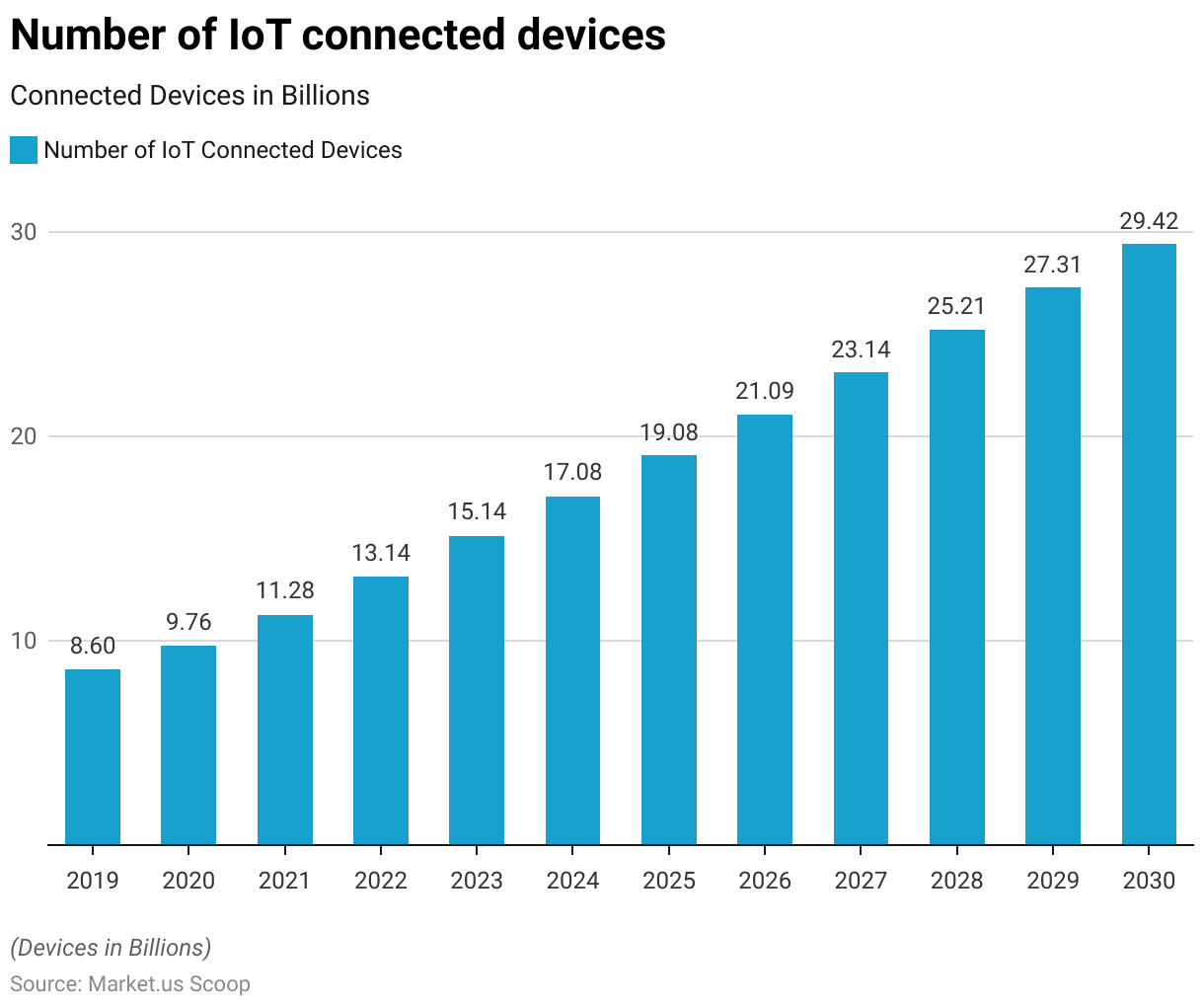
Geographic Adoption Variances
The United Kingdom
- In the UK, smart home products are used by 5.3 million households, representing 19.7% of the total 27.8 million households.
- However, this adoption rate lags behind that of the United States and China.
- The anticipated revenue of the UK’s smart home market in 2022 is £7.85 billion (equivalent to 6.58 billion GBP), with a potential growth rate of around 16%, which could elevate the market’s value to GBP 11.94 billion by 2026.
- During the pandemic, UK households spent a substantial £33 billion on smart devices as individuals sought to enhance their home experiences while adhering to safety measures.
- Among UK internet users aged 16-64, 24.9% own at least one smart home device, and Ireland also demonstrates a notable percent usage rate of 22%.
- Notably, 64% of UK residents invested in smart products in 2018, with 42% allocating £100 or more for such purchases.
- Additionally, 65% of homeowners are willing to pay extra for a smart home, indicating a strong interest in this technology.
- The average spending on smart products is anticipated to grow by 30%.
(Source: Meteor Electrical)
Germany
- Following the UK, Germany emerged as a promising market for smart technology growth. German residents conduct an average of 107,480 monthly searches for smart home products, with “Smart TV” accounting for 90,500.
- According to the German industry association Bitkom, 41% of Germans owned at least one smart home device in 2021, and this number is expected to rise steadily in the coming years, indicating significant growth in the German smart technology market, encompassing nearly 40 million people.
- Television and connectivity products are Germany’s most popular smart devices, offering insights for local technology manufacturers to enhance smart home entertainment and connectivity products.
- Currently, 16% of Germans utilize smart products through apps, which is anticipated to reach 25% soon.
- Germany’s smart home market revenue is projected to reach $6.62 billion by 2026, trailing the UK’s projected revenue by $1.32 billion.
(Source: Meteor Electrical)
United States
- The United States leads the world in smart home adoption, boasting the highest penetration rate for these technologies.
- In 2022, an estimated 47.4 million smart homes were present in the US out of 140 million households, indicating that nearly 35% of all US homes have embraced smart technologies.
- This marks a significant increase of approximately 17.9 million households compared to 2018, underscoring the steady growth of smart homes in the US.
- Smart home sales in the US will reach USD 47 billion by 2025, double the sales recorded in 2020.
- On average, each American allocates $146 annually for smart home products.
- Furthermore, in 2022, 23% of broadband households in the US boasted three or more smart devices and appliances, reflecting a substantial presence of smart technology in American homes.
(Source: Meteor Electrical)
China
- China ranks as the second-largest market for the growth of smart home technology, boasting 68 million smart households within a total of 500 million households in the country.
- China’s smart home technology market is poised for substantial expansion, with an anticipated revenue surge of USD 23.63 billion in 2022.
- The revenue generated by smart home products exhibits consistent growth at a rate of 15.8%, ultimately leading to a projected market size of $42.6 billion by 2026.
- Chinese homeowners focus on connectivity, comfort, and lighting through smart devices.
- Projections indicate that by 2026, the number of active smart households will reach 142 million users.
- The smart home penetration rate currently stands at 16.6%, with expectations of it ascending to 29% by 2026.
- In 2018, the revenue from smart home security in China amounted to $1.8 million, while the total revenue from smart home appliances in the country reached $7.6 million.
(Source: Meteor Electrical)
User Behavior and Preferences
User Investment Preferences by Smarter Devices Statistics
- People increasingly invest in various smart home applications to enhance their living environments.
- Among the categories, “Home Security” emerges as a top priority, with 55.56% of individuals planning to allocate funds to bolster their home’s security measures.
- Following closely, “Management of Household” garners significant interest, with 52.63% intending to invest in technologies that streamline household management tasks.
- “Energy Efficiency” also holds appeal, with 35.29% of respondents seeking to make their homes more energy-efficient.
- “Entertainment” and “Healthcare & Wellness” draw investment from 35.29% and 33.33% of participants, respectively, indicating a desire to incorporate technology into leisure and well-being.
- “Home Décor & Comfort” and “Personal Assistance” round out the preferences, with 25% and 22.58% of respondents willing to invest in these areas, respectively.
- This data highlights a growing commitment to smart home technologies across multiple aspects of modern living.
(Source: GoodFirms)
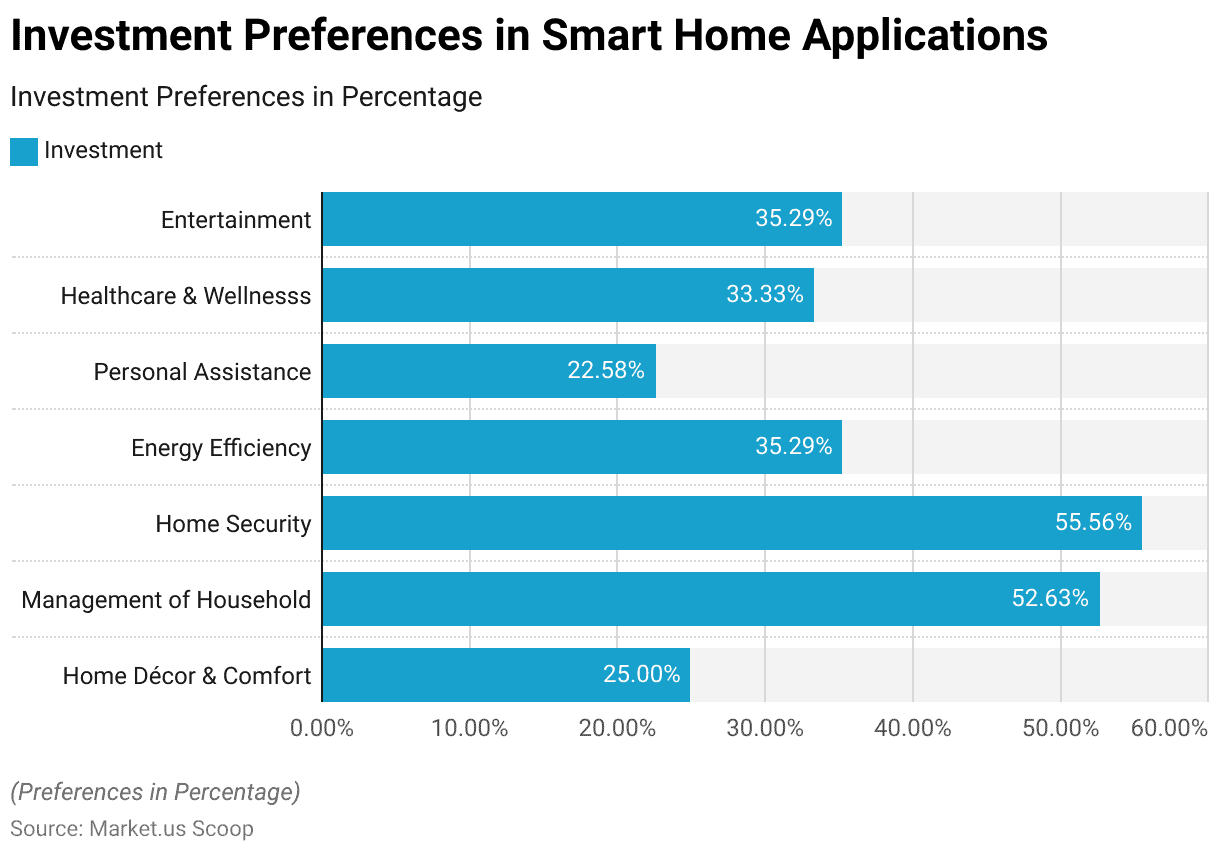
Smarter Devices Ownership by Age Group Statistics
- Ownership of smart home devices varies significantly across different age groups.
- Millennials lead the pack, with 64.71% of individuals in this age bracket owning smart home devices.
- Gen X, the generation that came before them, also demonstrates a considerable interest in smart home technology, with 50% adopting these devices.
- In contrast, Gen Z, the youngest cohort, currently shows a lower ownership rate at 25%.
- These statistics reflect how the adoption of smart home devices is influenced by generational differences, with Millennials being the most enthusiastic users, likely due to their familiarity with technology and greater economic independence compared to Gen Z.
(Source: GoodFirms)
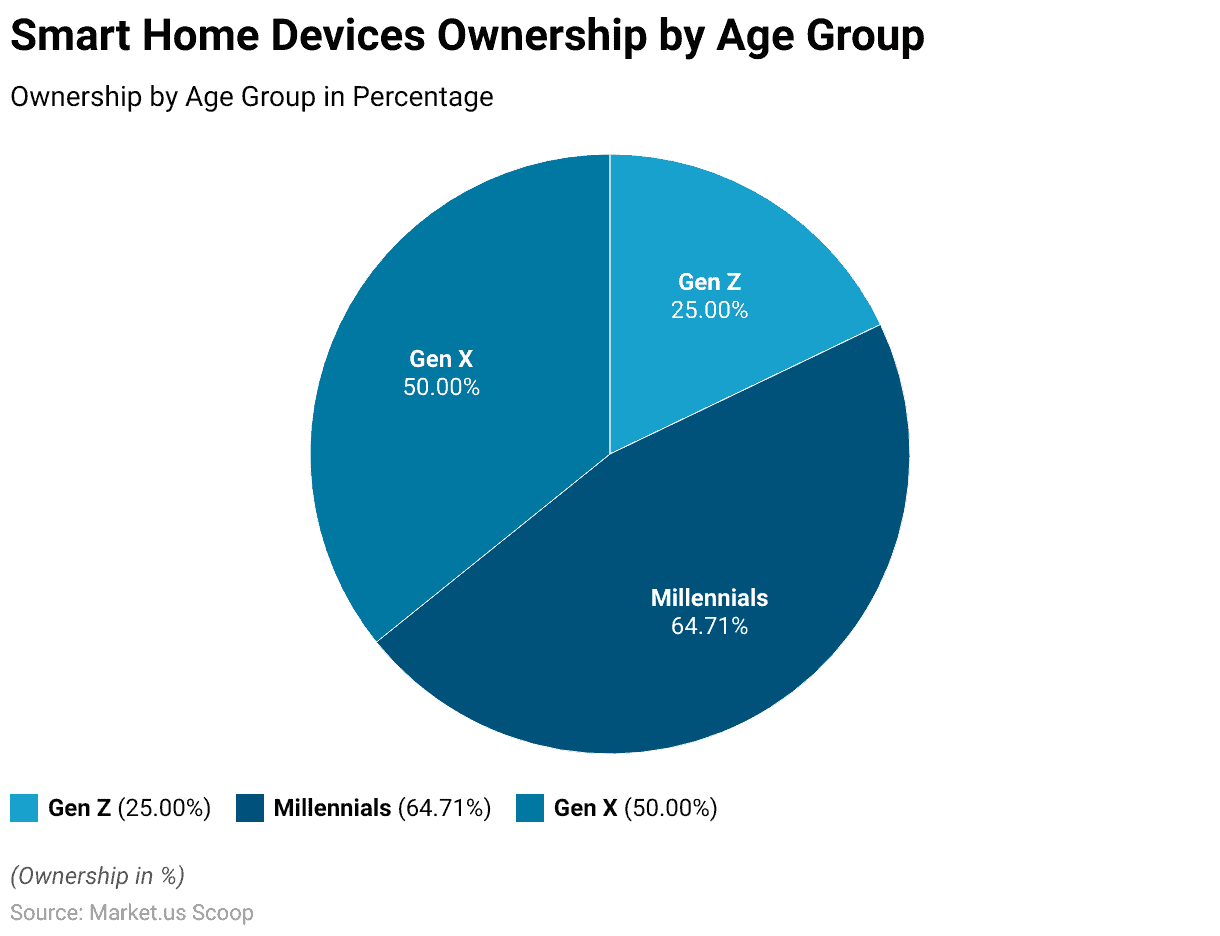
Popular Smarter Devices Preferences of Users Statistics
- Regarding user preference for smart home device brands, there are a few standout choices.
- Nest leads the pack, with 37.5% of users expressing a preference for their products, closely followed by Amazon at 36.46%.
- Philips Hue and Samsung share an 8.33% preference rate, indicating moderate interest in their offerings.
- Ring, known for its home security solutions, captures 7.29% of user preference.
- Ecobee and Kasa, though garnering less attention, still have their share of enthusiasts, with 3.13% and 2.08% of users favoring them, respectively.
- These statistics underscore the competitive landscape of the smart home market, with Nest and Amazon standing out as the top choices for a significant portion of users. At the same time, other brands also find their niches in consumers’ preferences.
(Source: GoodFirms)
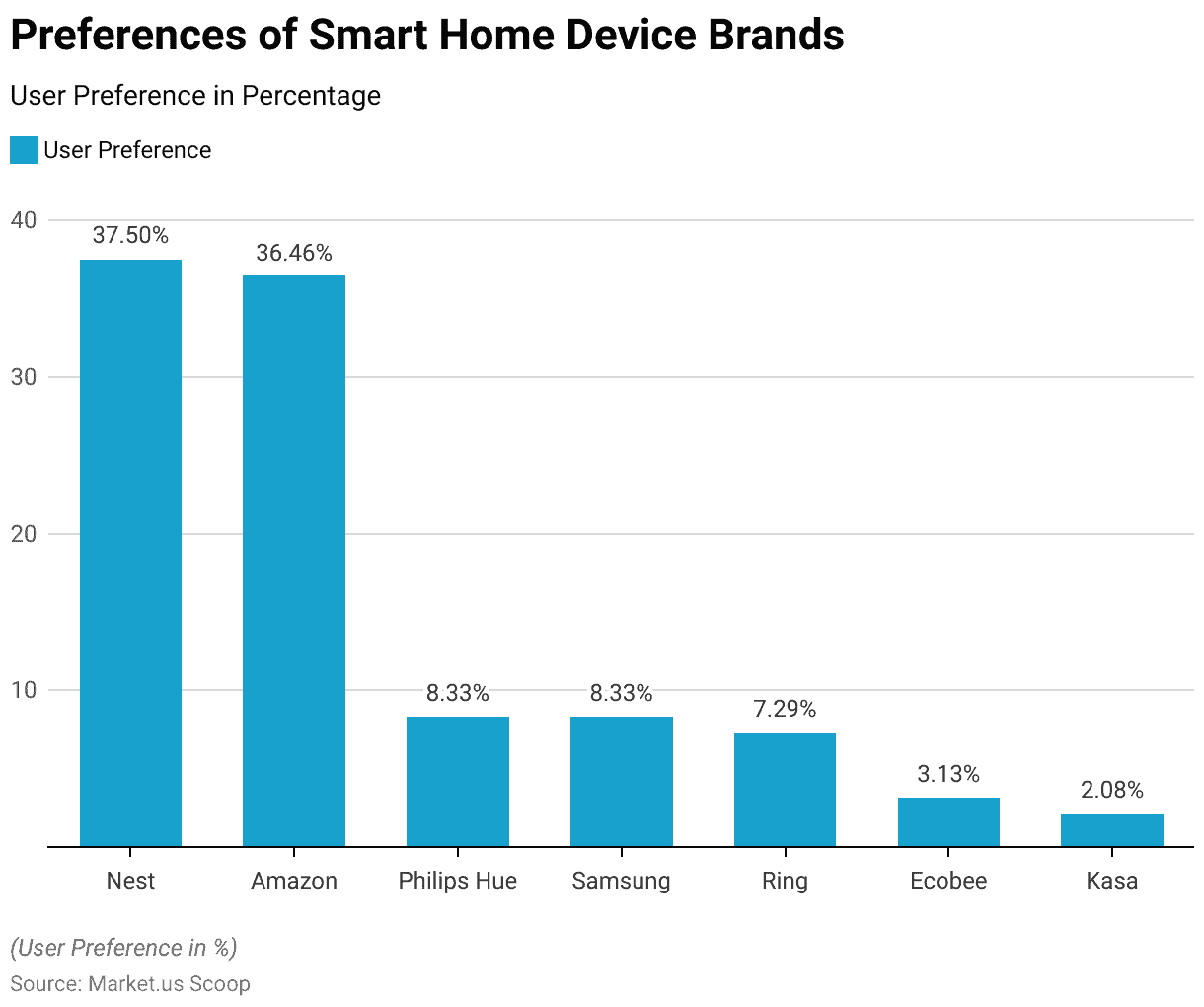
Key Features and Technologies
Artificial Intelligence (AI) Integration by Smarter Devices Statistics
- Currently, 35% of businesses have adopted AI, with 42% considering future AI implementation.
- The forecasts the global AI market to reach around $266.92 billion by 2027.
- In 2020, the U.S. saw over 10 million active voice assistant installations.
- McKinsey & Company suggests AI could add a significant $13 trillion to the global economy by 2030.
- Healthcare widely embraces AI, with a $6.6 billion market in 2021.
- By 2030, up to 30% of jobs may be automated through AI.
- The global AI market in education is projected at $3.68 billion by 2023.
- An MIT Technology Review survey finds that 81% of business executives see AI as a major competitive advantage.
- The global chatbot market is expected to hit $9.4 billion by 2024.
- Implementing AI in customer service can yield up to 30% cost savings.
- AI-powered chatbots in finance could save banks $7.3 billion by 2023.
- PwC’s research suggests AI could contribute up to $15.7 trillion to the global economy by 2030.
(Source: Cross River Therapy)
Connectivity and Communication Protocols By Smarter Devices Statistics
- The global Control and connectivity market is on track to reach a revenue of approximately US$23.3 billion in 2022.
- This industry is primed for substantial expansion, with an expected annual growth rate of 12.01% (CAGR 2022-2028), resulting in a projected market size of US$48.9 billion by 2028.
- Regarding active households, it’s foreseen that the Control and connectivity market will encompass roughly 643.4 million households by 2028.
- The household adoption rate is predicted to climb from 6.8% in 2022 to 27.2% by 2028.
- The average revenue generated per installed Smart Home is estimated at around US$156.90.
- In terms of global revenue comparison, the United States emerges as the frontrunner, generating the highest revenue of US$7,994.0 million in 2022.
- The United States maintains its leading position in the global Control and connectivity market thanks to its advanced technologies and steadfast commitment to innovation.
(Source: Statista)
Concerns Related to Adoption of Smarter Devices
Privacy Concerns by Smarter Devices Statistics
- Data security is a significant worry for consumers, as demonstrated by research carried out by Parks Associates.
- Their findings reveal that 49% of individuals who utilize connected devices have faced at least one data security or privacy issue.
- Additionally, almost 75% of households exhibit various levels of concern, with many expressing a high degree of worry regarding spyware or viruses on their smart devices.
- According to Parks Associates consumer data, the typical number of connected devices in households is 16, and individuals who own smart home devices generally possess an average of eight such devices.
- The increasing adoption of these devices contributes to an elevated level of concern and a greater frequency of issues encountered.
- The data from Parks Associates underscores that 25% of the market remains hesitant to adopt technology due to apprehensions related to data privacy.
(Source: Parks Associates)
Security Concerns by Smarter Devices Statistics
- According to research by Parks Associates, 72% of consumers express varying levels of concern, with many being very concerned about the security of their data collected and transmitted by devices.
- They also harbor concerns about unauthorized access or control of their smart devices.
- Among users of smart home devices, 55% of consumers worry about the potential for hackers gaining access, while 39% have concerns about technology companies gaining unauthorized access.
- This issue remains a substantial barrier to adoption, which industry players must actively address.
- Consumer apprehensions regarding privacy breaches, even by legitimate entities, have persisted.
- Notably, only 37% of consumers trust companies with access to their data. Paraphrase this and avoid AI content.
(Source: Parks Associates)
Recent Developments
Acquisitions and Mergers:
- Google acquires Fitbit: In early 2024, Google completed its acquisition of Fitbit for $2.1 billion. This acquisition aims to integrate Fitbit’s health-tracking technology with Google’s AI and machine learning capabilities to create smarter health and fitness devices.
- Amazon acquires Eero: Amazon acquired Eero, a company specializing in mesh Wi-Fi systems, for $97 million in late 2023. This merger is intended to enhance Amazon’s smart home ecosystem by providing better connectivity solutions for its smart devices.
New Product Launches:
- Apple HomePod Mini with Siri Intelligence: Apple launched the HomePod Mini in October 2023, featuring improved Siri intelligence, enhanced sound quality, and new smart home integration capabilities, aiming to compete in the smart speaker market.
- Samsung SmartThings Hub 3.0: Samsung introduced the SmartThings Hub 3.0 in early 2024, offering advanced connectivity options, improved AI-driven automation, and compatibility with a wider range of smart home devices.
Funding:
- Xiaomi raises $1 billion: Xiaomi secured $1 billion in a funding round in 2023 to expand its portfolio of smart home devices and enhance its AI and IoT capabilities, focusing on creating a seamless smart home ecosystem.
- SmartThings raises $300 million: SmartThings, a leader in smart home technology, raised $300 million in early 2024 to scale its operations and invest in the development of new smart home products and AI-driven features.
Technological Advancements:
- AI Integration in Smart Devices: The integration of AI in smart devices has advanced significantly, with features like voice recognition, predictive maintenance, and personalized user experiences becoming more sophisticated.
- 5G Connectivity: The rollout of 5G technology is enhancing the performance and capabilities of smarter devices by providing faster data transfer rates, lower latency, and more reliable connections, crucial for the development of advanced IoT applications.
Market Dynamics:
- Growth in Smart Home Market: The global smart home market is projected to grow at a CAGR of 23% from 2023 to 2028, driven by increasing consumer demand for convenience, security, and energy efficiency.
- Increased Adoption of Smart Wearables: The adoption of smart wearables such as fitness trackers and smartwatches continues to rise, with a projected market growth of 20% annually, driven by health-conscious consumers and advancements in wearable technology.
Regulatory and Strategic Developments:
- Data Privacy Regulations: With the proliferation of smart devices, there is a growing emphasis on data privacy regulations. Governments are implementing stricter guidelines to ensure that smart device manufacturers protect user data and comply with privacy standards.
- Interoperability Standards: Industry groups are working on establishing interoperability standards for smart devices to ensure seamless integration and communication across different platforms and ecosystems, enhancing the user experience.
Research and Development:
- Energy-Efficient Smart Devices: R&D efforts are focusing on developing energy-efficient smart devices that can operate longer on less power, addressing consumer concerns about battery life and sustainability.
- Enhanced Voice Assistants: Researchers are improving voice assistant technology, making them more accurate, responsive, and capable of understanding complex commands, thereby enhancing their utility in smart devices.
Conclusion
Smarter Devices Statistics: To sum it up, the world of smart devices and technology is undergoing rapid changes, with substantial growth anticipated across global markets.
Whether by expanding smart home gadgets or adopting IoT-connected devices, the tech industry constantly innovates and reshapes our daily lives and work routines.
However, this progress also brings challenges, particularly regarding data security and privacy issues, which demand attention to foster consumer confidence and encourage further adoption.
Consumers and industry stakeholders must navigate these changes cautiously and vigilantly in this increasingly interconnected world.
FAQs
Smarter devices are technological gadgets with advanced features and capabilities, often connected to the internet and designed to enhance convenience, automation, and efficiency in various aspects of life, such as home, work, and personal activities.
Smarter devices encompass a wide range of products, including smart home appliances (e.g., thermostats, lights, and locks), wearable technology (e.g., smartwatches and fitness trackers), IoT-connected devices (e.g., sensors and cameras), and more.
Smarter devices collect and process data using sensors, connectivity, and software applications. They often use wireless technologies like Wi-Fi, Bluetooth, or Zigbee to communicate with other devices or the internet, enabling remote control and automation.
Smarter devices offer various benefits, such as increased convenience, energy efficiency, security, and productivity. They can simplify tasks, save time and money, and provide valuable insights through data analysis.
Yes, security and privacy concerns are important considerations when using smarter devices. These devices collect and transmit data, which may be vulnerable to hacking or unauthorized access. It’s essential to implement security measures, like strong
Discuss your needs with our analyst
Please share your requirements with more details so our analyst can check if they can solve your problem(s)



